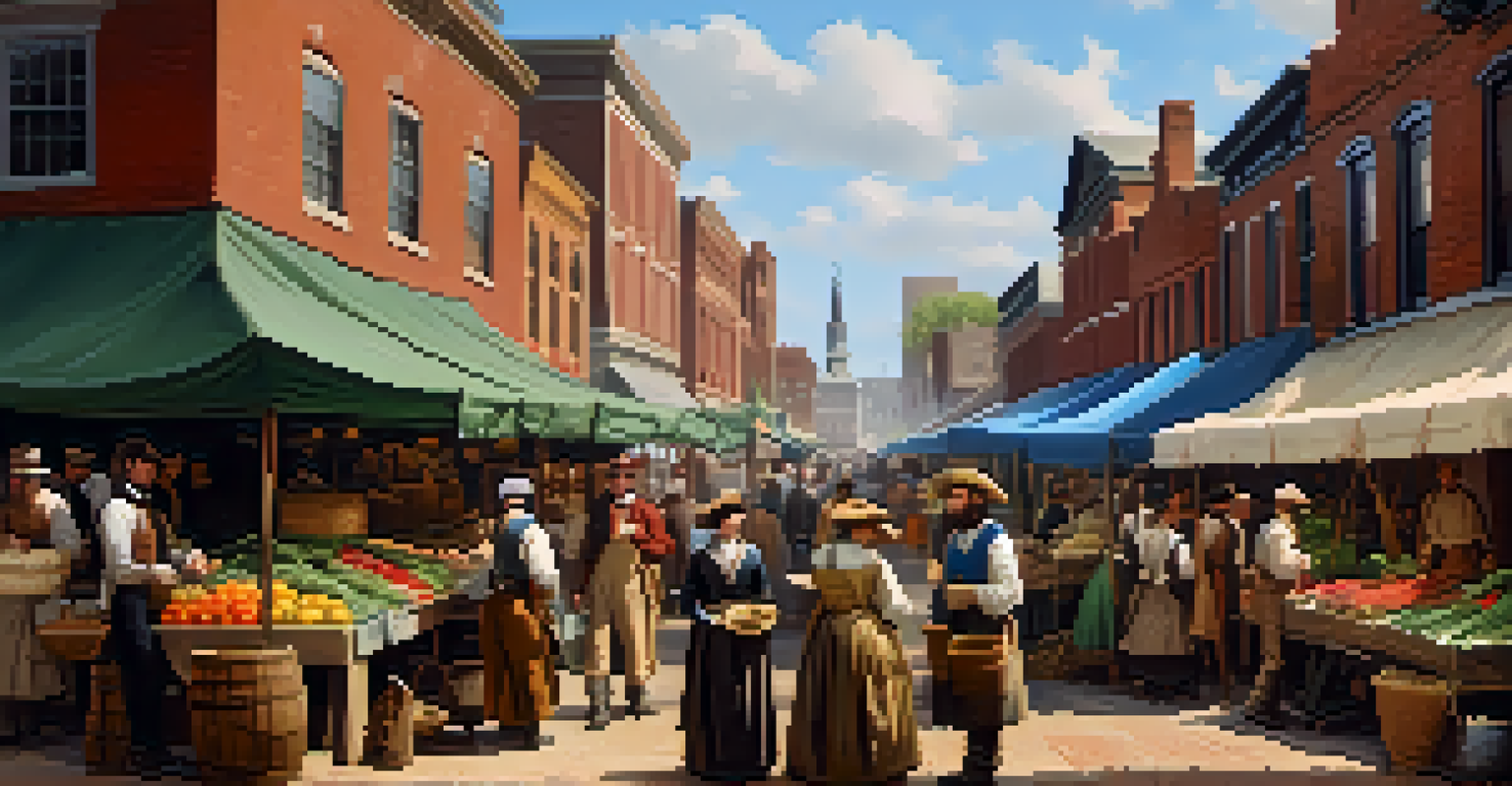The Role of St. Louis in the Westward Expansion

St. Louis: The Gateway to the West
St. Louis earned the nickname 'Gateway to the West' due to its strategic location along the Mississippi River. This city became a pivotal launching point for explorers, settlers, and traders heading into the uncharted western territories. Its proximity to the river facilitated transportation and commerce, making it an essential hub for those seeking new opportunities.
The West is a place where the world is being remade, a place of opportunity and adventure.
As pioneers set out for the vast lands beyond the Mississippi, St. Louis provided the necessary resources, supplies, and information vital for their journey. The city's bustling markets offered everything from food to tools, helping settlers prepare for their adventures. The community spirit in St. Louis played a key role in supporting those embarking on perilous journeys into the unknown.
Moreover, the famous Lewis and Clark Expedition set out from St. Louis in 1804, underscoring its importance in the exploration of the West. This journey not only expanded American territory but also ignited interest in westward migration. St. Louis became the first stop for many, symbolizing hope and opportunity in the vast American landscape.
Economic Growth and Trade Routes
The economic landscape of St. Louis flourished during the westward expansion, primarily due to its role as a trading post. As settlers moved westward, the demand for goods skyrocketed, and St. Louis became a central marketplace where traders could exchange products. This vibrant economy attracted merchants and entrepreneurs, further enhancing the city's growth.

St. Louis also served as a pivotal junction for various transportation routes, including riverboats, railroads, and trails. The development of the steamboat revolutionized trade, allowing for quicker and more efficient transport of goods up and down the Mississippi River. This accessibility made St. Louis a magnet for commerce, resulting in a bustling economy that supported westward migration.
St. Louis: A Key Trade Hub
St. Louis thrived as a central marketplace during westward expansion, facilitating the exchange of goods and attracting merchants and settlers.
As the railroads expanded in the mid-19th century, St. Louis continued to solidify its status as a critical trade hub. The arrival of the railroads connected the city to distant markets, enabling the efficient movement of agricultural products and other goods. This infrastructure not only fueled the local economy but also facilitated the westward movement of settlers seeking new lands.
Cultural Melting Pot of the West
St. Louis was not just a logistical hub; it was a cultural melting pot that welcomed immigrants from various backgrounds. As people from Europe and other regions arrived, they brought their traditions, languages, and cuisines, enriching the city's cultural fabric. This diversity played a significant role in shaping the identity of St. Louis during the westward expansion.
The journey of a thousand miles begins with one step.
This vibrant mix of cultures also fostered a sense of community among settlers preparing to move west. Social gatherings, cultural festivals, and communal support systems emerged, providing a sense of belonging for newcomers. The shared experiences of settling in a new land helped to create bonds that would carry through the challenges of westward migration.
Additionally, the arts flourished in St. Louis, with music, literature, and theater reflecting the diverse influences of its residents. The city became known for its lively music scene, particularly jazz and blues, which would later echo throughout the nation. This cultural richness not only made St. Louis an appealing destination but also a vital part of the larger narrative of the American West.
The Role of Forts and Military Presence
The establishment of military forts around St. Louis contributed significantly to its role during westward expansion. These forts provided protection for settlers and travelers against potential conflicts with Native American tribes. The military presence reassured many who were apprehensive about venturing into unfamiliar territories, facilitating safer migrations.
Forts also served as supply stations, offering food, shelter, and medical care to weary travelers. This support was crucial, as many settlers faced harsh conditions and uncertain landscapes on their journeys. The military's involvement helped to stabilize the region, making it a more attractive option for those looking to start anew.
Cultural Diversity Shaped Identity
The city's vibrant mix of immigrant cultures contributed significantly to its identity, fostering community and enriching the local arts scene.
Moreover, the military's interactions with native tribes often influenced the dynamics of westward expansion. While some forts were established for protection, others were used to assert control over territories. This complex relationship shaped the experiences of both settlers and indigenous peoples, highlighting the often contentious nature of American expansion.
Transportation Innovations and Their Impact
Transportation innovations played a critical role in facilitating westward expansion, with St. Louis at the forefront of these developments. The advent of the steamboat transformed river travel, significantly reducing the time it took to transport goods and people. This advancement allowed settlers to move more efficiently into the western territories, making St. Louis an essential point of departure.
As railroads began to crisscross the country, St. Louis adapted to these changes, becoming a major rail hub. The introduction of trains allowed for even faster movement of settlers and supplies, connecting the city to wider markets and facilitating trade. This interconnectedness helped to solidify St. Louis's status as a gateway for those seeking new beginnings.
Ultimately, these transportation innovations not only impacted St. Louis but also altered the landscape of America itself. As more people moved west, they brought with them their aspirations and dreams, reshaping the cultural and economic fabric of the nation. The evolution of transportation from St. Louis became emblematic of the broader journey into the American frontier.
The Legacy of St. Louis in American History
Today, the legacy of St. Louis in the context of westward expansion is still evident in its historical sites and monuments. Landmarks such as the Gateway Arch commemorate the city's pivotal role as a launching point for countless settlers seeking new lives. This iconic structure stands as a symbol of exploration and the spirit of adventure that defined an era.
Moreover, the stories of those who passed through St. Louis continue to resonate, offering insights into the challenges and triumphs of westward migration. Museums and cultural centers in the city preserve these narratives, ensuring that future generations understand the significance of this period in American history. These stories reflect the diverse experiences of settlers, highlighting both the hopes and struggles they faced.
Legacy of Exploration and Resilience
Today, St. Louis stands as a symbol of exploration and resilience, with its historical significance reflected in landmarks and ongoing cultural diversity.
As we reflect on the impact of St. Louis, it is essential to recognize the complexities of westward expansion. While the movement opened up new opportunities, it also led to significant challenges for indigenous populations. Understanding this duality is crucial in appreciating the rich tapestry of American history that St. Louis played a vital role in shaping.
Modern St. Louis: A City of Resilience
In contemporary times, St. Louis continues to embody the spirit of resilience and adaptability that characterized its role during westward expansion. The city has faced numerous challenges, from economic shifts to social changes, yet it remains a vibrant urban center. Efforts to revitalize neighborhoods and promote local businesses reflect a determination to honor its historical legacy while building a brighter future.
The cultural diversity that once defined St. Louis during the westward movement persists today, with a rich tapestry of communities contributing to the city's identity. Festivals celebrating various heritages, culinary diversity, and artistic expressions showcase the ongoing influence of its immigrant history. This cultural richness continues to attract visitors and residents alike.

As St. Louis looks to the future, it carries with it the lessons learned from its past. The city serves as a reminder of the importance of community, collaboration, and the pursuit of opportunities. Just as it was a gateway to the West, St. Louis remains a bridge connecting history with the ongoing journey of progress and innovation.